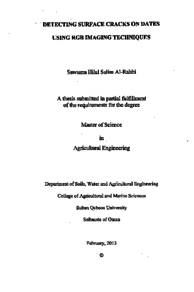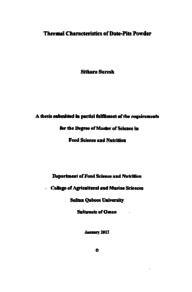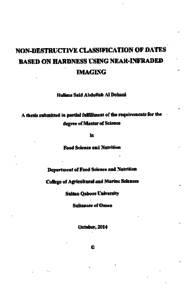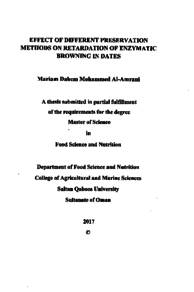Document
Detecting surface cracks on dates using RGB imaging techniques.
Publisher
Sultan Qaboos University
Gregorian
2012
Language
English
English abstract
Oman produces an average of 268,011 tonnes of dates annually. But the annual export from Oman is low mainly due to the poor quality of the processed and packaged dates. Surface crack is a type of defects which depreciates date quality. At present, cracked dates in processing and packing lines are removed manually by graders. The efficiency of manual sorting is affected by several factors such as the variation in human visual inspection. The objective of this study was to determine the efficiency of a computer vision system with RGB color camera to detect the surface cracks on dates. Three grades of 'Khalas' variety dates (high-crack dates, low crack dates and no-crack dates) were obtained from two commercial dates processing factories in Oman. After the confirmation of grade standards by a dates quality-expert, the samples were imaged individually using a color camera (105 dates in each grade). Eleven features were extracted from each image and used in classification models. Red, hue and value intensities of three grades of dates were significantly different from each other. In a three classes model, the classification accuracy was 62%, 58% and 78% for high-crack, low-crack and no-crack dates, respectively using linear discriminant analysis (LDA). LDA yielded a classification accuracy of 88% and 75% for the dates with-crack and without-crack, respectively in a two classes model. In pairwise discrimination, the highest classification (96%) was achieved between high-crack and no-crack dates, and the lowest accuracy (59%) was between low-crack and high-crack dates. The skin delamination was the main reason of the misclassification,
Member of
Resource URL
Arabic abstract
تنتج سلطنة عمان حوالي 268 , 011 طنا من التمور سنويا. ولكن نسبة التصدير السنوي من التمور في السلطنة قليلة جدا، والسبب الرئيسي في ذلك هو الجودة المنخفضة التمور المصنعة والمعبأة. التشققات التي تتكون على سطح التمور هي من العيوب التي تؤثر على جودتها سلبيا. في الوقت الحالي، يتم التخلص من التمور المصابة بالتشققات عن طريق العمالة البشرية في مصانع التمور. ومدى صحة هذه العملية تعتمد على عدة عوامل، أهمها الاختلاف في الرؤية البشرية . لذلك كان الهدف من هذه الدراسة هو ابتكار نموذج لبرنامج حاسوبي للكشف عن التمور المصابة بالتشققات السطحية باستخدام تقنية التصوير الملون وتصنيفها اعتمادا على ذلك. وقد تم تجميع عينات التمور من صنف الخلاص من عدة مصانع التمور في عمان. ثم تم تصنيف هذه العينات - يدويا وتحت إشراف خبير في جودة التمور- إلى تمور بتشققات كثيرة وتمور بتشققات قليلة وتمور بدون تشققات. وتم تصوير كل عينة باستخدام كاميرا رقمية ملونة. ثم تم معالجة وتحليل الصور في الحاسب الآلي باستخدام برنامج (MATLAB). في هذا البرنامج، تم تحويل صيغة الصور إلى صيغة (HSV) والتي تعتمد على درجة وصفاء وإشراق اللون. ثم تم استخدام مستوى إشراق اللون من هذه الصيغة لفصل التمرة عن خلفية الصورة. وبعدها استخدمت الصورة الثنائية لهذا المستوى (أبيض وأسود) في حساب مساحة التشققات في كل تمرة. بالإضافة إلى ذلك تم استخراج حوالي 10 خصائص من كل صورة. ثم تم تحليل البيانات الناتجة من جميع الصور باستخدام تقنية تحليل التمايز الخطي لحساب دقة التصنيف التي قام بها النموذج المبتكر. أوضحت النتائج أن النموذج قابل التصنيف التمور إلى ثلاثة أصناف بنسبة 67 . 3 % ، وأيضا بإمكان النموذج ضبط التمور المتشققة وتميزها عن التمور النقية بنسبة 84 . 4 % . ولقد استنتج أن تقشر التمور بسبب الجفاف هو السبب الرئيسي في حدوث الأخطاء في التصنيف. لذلك ينصح باستخدام هذه النموذج المبتكر في أصناف التمور قليلة القشور مثل صنف النعيم". وكذلك يمكن أن يطور النموذج لضبط وتصنيف تمور الخلاص المتشققة بنسبة أعلى، إذا ما تم التمييز بين التشققات والقشور على سطح التمرة.
Category
Theses and Dissertations




